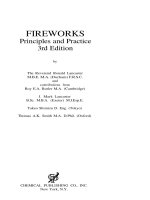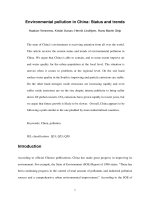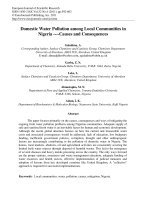IONIC LIQUIDS – CLASSES AND PROPERTIES pot
Bạn đang xem bản rút gọn của tài liệu. Xem và tải ngay bản đầy đủ của tài liệu tại đây (6.68 MB, 360 trang )
IONIC LIQUIDS – CLASSES
AND PROPERTIES
Edited by Scott T. Handy
Ionic Liquids – Classes and Properties
Edited by Scott T. Handy
Published by InTech
Janeza Trdine 9, 51000 Rijeka, Croatia
Copyright © 2011 InTech
All chapters are Open Access articles distributed under the Creative Commons
Non Commercial Share Alike Attribution 3.0 license, which permits to copy,
distribute, transmit, and adapt the work in any medium, so long as the original
work is properly cited. After this work has been published by InTech, authors
have the right to republish it, in whole or part, in any publication of which they
are the author, and to make other personal use of the work. Any republication,
referencing or personal use of the work must explicitly identify the original source.
Statements and opinions expressed in the chapters are these of the individual contributors
and not necessarily those of the editors or publisher. No responsibility is accepted
for the accuracy of information contained in the published articles. The publisher
assumes no responsibility for any damage or injury to persons or property arising out
of the use of any materials, instructions, methods or ideas contained in the book.
Publishing Process Manager Alenka Urbancic
Technical Editor Teodora Smiljanic
Cover Designer Jan Hyrat
Image Copyright Pedro Salaverría, 2011. Used under license from Shutterstock.com
First published September, 2011
Printed in Croatia
A free online edition of this book is available at www.intechopen.com
Additional hard copies can be obtained from
Ionic Liquids – Classes and Properties, Edited by Scott T. Handy
p. cm.
ISBN 978-953-307-634-8
free online editions of InTech
Books and Journals can be found at
www.intechopen.com
Contents
Preface IX
Part 1 Classes of Ionic Liquids 1
Chapter 1 1,2,3-Triazolium Salts as a
Versatile New Class of Ionic Liquids 3
Zekarias Yacob and Jürgen Liebscher
Chapter 2 Thiazolium and Benzothiazolium Ionic Liquids 23
Munawar Ali Munawar and Sohail Nadeem
Chapter 3 Glycoside-Based Ionic Liquids 65
Robert Engel
Chapter 4 Ionic Liquids from (Meth) Acrylic Compounds 81
Sindt M., Mieloszynski J.L. and Harmand J.
Part 2 Theoretical Studies 105
Chapter 5 Theoretical Description of Ionic Liquids 107
Enrico Bodo and Valentina Migliorati
Chapter 6 Classical Density Functional Theory of Ionic Liquids 127
Jan Forsman, Ryan Szparaga, Sture Nordholm,
Clifford E.Woodward and Robert Penfold
Part 3 Physical Properties 151
Chapter 7 Interactions and Transitions in
Imidazolium Cation Based Ionic Liquids 153
Madhulata Shukla, Nitin Srivastava and Satyen Saha
Chapter 8 High Pressure Phase Behavior of Two Imidazolium-Based
Ionic Liquids, [bmim][BF
4
] and [bmim][PF
6
] 171
Yukihiro Yoshimura, Takekiyo Takekiyo,
Yusuke Imai and Hiroshi Abe
VI Contents
Chapter 9 Dielectric Properties of Ionic
Liquids Proposed to Be Used in Batteries 187
Cserjési Petra, Göllei Attila,
Bélafi-Bakó Katalin and Gubicza László
Chapter 10 Translational and Rotational Motions for
TFSA-Based Ionic Liquids Studied by NMR Spectroscopy 209
Kikuko Hayamizu
Part 4 Applications in Synthesis 237
Chapter 11 Ionic Liquids Recycling for Reuse 239
Samir I. Abu-Eishah
Chapter 12 Ionic Liquids in Green Carbonate Synthesis 273
Jianmin Sun, Ruixia Liu,
Shin-ichiro Fujita and Masahiko Arai
Chapter 13 Ionic Liquids in Polar Diels-Alder Reactions Using
Carbocycles and Heterocycles as Dienophiles 311
Mancini Pedro M.E., Kneeteman María,
Della Rosa Claudia, Bravo Virginia and Adam Claudia
Preface
Ionic liquids (more specifically, room temperature ionic liquids (RTIL)) have
attracted considerable interest over the last few years. Although the specific
definition of what an RTIL is varies from person to person, the prevailing definition
would be that it is a salt with a melting point below 100 °C. Such a broad definition
leaves considerable room for flexibility, which contributed to labeling RTILs as
“designer solvents.”
1
The history of ionic liquids (and the closely related molten salts) has a rather ill-
defined beginning, although it is most commonly dated back to 1914 and the work
of Walden on the use of alkylammonium nitrates.
2,3
The next burst of interest
occurred with the discovery of chloroaluminates formed by combining quaternary
heterocyclic cations with aluminum chloride. These materials exhibited a great deal
of potential for use in a variety of areas, but all suffered from extreme sensitivity to
moisture.
A major step forward was made by Wilkes in the early 1990’s, with the report of
moisture stable ionic liquids created by replacing the aluminum chloride with other
anions, such as tetrafluoroborate or hexafluorophosphate.
4
Since that seminal report by Wilkes and co-workers, the family of RTILs has seen
explosive growth. Starting with imidazolium cations, the cationic component has been
varied to include pyridinium, ammonium, phosphonium, thiazolium, and triazolium
species.
5
In general, these cations have been combined with weakly coordinating
anions, although not all weakly coordinating anions result in RTILs (for example, the
very weakly coordinating polyhedral borane anions of Reed afford salts with melting
points between 45 and 156 °C for a series of imidazolium cations).
6
Common examples
include tetrafluoroborate, hexafluorophosphate, triflate, triflimide, and dicyanimide.
The first two have been explored the most, and must be treated with the greatest
caution as they are fairly readily hydrolyzed to boric acid and phosphate respectively.
7
Indeed, various phosphate and phosphinate anions have been employed to some
advantage in RTILs.
8
The list of possible anionic components continues to grow at a
rapid rate.
X Preface
Several chapters in this volume display the increasing variability found in the family
of components used to prepare RTILs, notably those of Sindt, Mieloszynki, and
Harmand; Yacob and Liebscher; Engel; and Munawar and Nadeem.
Fig. 1. Representative Ionic Liquid Components
The remaining focus of interest in RTIL research are methods for determining and
predicting their physical properties, especially since their unusual and tunable
properties are often mentioned as one of the key advantages of RTILs over
conventional solvents. Several chapters in this volume focus on this area as well,
including those by Shukla, Srivastava, and Saha; Bodo and Migliorati; Forsman,
Szparaga, Nordholm, Woodward, and Penfold; Hayamizu; Yoshimura, Takekiyo, Imai
and Abe; and Petra, Attila, Katalin, and Laszlo. However, even with this impressive
effort, there is still a lot of work to be done before the true power of RTILs as designer
solvents (i.e. predictable selection of a particular RTIL for any given application) is
effectively harnessed.
Cation
Anion
N
N
N
R
R
R
4
N
R
4
P
BF
4
PF
6
N(CN)
2
NTf
2
Preface XI
Another problem/opportunity is that RTILs are fundamentally synthetic materials.
While this does render them highly tunable, it also means that concise, scalable,
efficient, and inexpensive synthetic routes to them are of extremely important.
The typical approach is to alkylate the starting nitrogen or phosphorous-containing
compound, generating the quaternary halide salt. (Scheme 1) At this point, anion
metathesis is employed to introduce the desired anion.
This seemingly simple chemistry has a number of problems associated to it. For the
alkylation step, the reactions can require long reaction times (up to several days) in
addition to higher temperatures (which can result in a number of side reactions make
the halide salt difficult to purify). The anion metathesis is also a generally slow
reaction (12+ hours) and can be difficult to push to completion. As a result, a number
of different methods have been reported for each of these two steps, including the use
of microwaves and sonication.
9
(Scheme 2)
Scheme 1. General Synthetic Route to RTILs
11
Scheme 2. Non-conventional Methods for the Synthesis of RTILs
10,
N
N
N
N
R
N
N
R
RX
Alkylation
Metathesis
X
A
A
N
N
N
N
R
N
N
R
BuBr
Alkylation Metathesis
Br PF
6
Method
80
C
sonication
microwave (240 W)
T
ime
5 h
2 h
75 sec
%
Yield
76
94
86
M
ethod
90
C
microwave (360 W)
T
ime
3 h
210 sec
%
Yield
36
91
N
N
R
Cl
NH
4
PF
6
XII Preface
Although this alkylation/metathesis approach is certainly quite flexible and reasonably
short, a one-step route to RTILs would be ideal. (Scheme 3) Several different attempts
to achieve this goal have been reported, including one-pot reactions (in which
alkylation and metathesis are combined),
12
alkylations using species other than alkyl
halides (such as alkyl sulfonates, eliminating the need for anion metathesis),
13
Michael
reactions with reactive Michael acceptors,
14
and simple protonation using strong
acids.
2
Scheme 3. One-pot Syntheses of RTILs
Even with all of the synthetic advances, one of the biggest limitations to the use of
RTILs is still their cost. Common RTILs remain quite expensive, particularly when
compared to conventional organic solvents. For example, the price of one liter of THF
is under $60, whereas butylmethylimidazolium tetrafluoroborate (one of the least
expensive RTILs at the moment) is over $2,000 per liter.
15
The price is an even bigger
issue if the most stable of the common RTILs are considered – the triflimides. The
triflimide anion is extremely expensive, making it unlikely that the RTILs will ever
become inexpensive. As a result, a very important area of study is in the design of
equally stable anions that are much less expensive.
Regardless of the method employed for synthesis, a key concern with RTILs is their
purity.
16
There are many possible impurities, but the most common (and the most
detrimental) are residual halides and undetermined colored impurities. As discussed
in the chapter by Abu-Eishah, there are a number of methods to purify contaminated
RTILs, and further impurities can often be avoided by use of careful synthetic
methods.
N
N
BuCl
NH
4
PF
6
N
N
Bu
PF
6
Method
140
C
sonication (80
C)
T
ime
30 min
30 min
%
Yield
29
59
C
ombined Alkylation and Metathesis
Sulfonate Alkylation
Michael Addition Protic
R
3
P
R'OTs
toluene
reflux, 16 h
95%
R
3
PR'
R = Ph
R' = Octyl
NH
N
OTs
O
89%
N
N
O
OTs
EtNH
2
HNO
3
NO
3
OTs
EtNH
3
Preface XIII
Much of the earliest interest in RTILs was as recyclable, “green” solvents for Organic
synthesis.
17
Indeed, by now, there is hardly any Organic reaction that has not been
reported in RTILs. In many of cases, there is little practical benefit to the use of a RTIL
instead of a conventional organic solvent. One clear exception to this statement is the
area of transition metal catalyzed reactions.
18
In such cases, there are dual advantages
to the use of RTILs. First, the transition metal catalyst is generally retained in the RTIL
layer and can thus be reused several times. Second, the RTIL often helps to stabilize
the transition metal catalyst and can result in systems which are also more reactive. A
few chapters in this volume deal with the use of RTILs in synthesis: Sun, Liu, Fujita,
and Arai; Xian, Yong, Hui, and Zhuo; Mancini, Kneeteman, Della Rossa, Bravo and
Adam; and Masahiko.
In conclusion, I hope this volume (and its companion, which focuses on the widely
varied applications of RTILs in science) will help to inspire further exploration of these
fascinating materials and result in many more valuable applications which will
improve the quality of life, as well as the environment in the future.
Sincerely,
Scott T. Handy,
Department of Chemistry
Middle Tennessee State University
Murfreesboro,
USA
References
[1] Freemantle, M. Chem. Eng. News 1998, 32-38.
[2] Walden, P. Bull. Acad. Imper. Sci. (St Petersburg), 1914, 1800.
[3] For an excellent review regarding the early history of ionic liquids, see Wilkes, J.S.
Green Chem. 2002, 4, 73.
[4] Wilkes, J.S.; Zaworotko, M.J. J. Chem. Soc. Chem. Commun. 1992, 965.
[5] Handy, S.T.; “Room Temperature Ionic Liquids: Different Classes and Physical
Properties.” Curr. Org. Chem. 2005, 9, 959-989.
[6] Larsen, A.; Holbrey, J.D.; Tham, F.S.; Reed, C.A. “Designing Ionic Liquids:
Imidazolium Melts with Inert Carborane Anions.” J. Am. Chem. Soc. 2000, 122,
7264-7272.
[7] Freire, M.G.; Neves, C.M.S.S.; Marrucho, I.M.; Coutinho, J.A.P.; Fernandes, A.M.
“Hydrolysis of Tetrafluoroborate and Hexafluorophosphate Counter Ions in
Imidazolium-Based Ionic Liquids.” J. Phys. Chem. A 2010, 114, 3744-3749.
[8] Lall, S.I.; Mancheno, D.; Castro, S.; Behaj, V.; Choen, J.I.; Engel, R. Polycations. Part
X. LIPs, a new category of room temperature ionic liquid based on
polyammonium salts.” Chem. Commun. 2000, 2413-2414.
XIV Preface
[9] Leveque, J-M.; Estager, J.; Draye, M.; Cravotto, G.; Boffa, L.; Bonrath, W. “Synthesis
of Ionic Liquids Using Non Conventional Activation Methods: An
Overview.” Monats. Chemie 2007, 138, 1103-1113.
[10] Namboodiri, V.V.; Varma, R.S. “Solvent-Free Sonochemical Preparation of Ionic
Liquids.” Org. Lett. 2002, 4, 3161-3163. Varma, R.S.; Namboodiri, V.V. “An
expeditious solvent-free route to ionic liquids using microwaves.” Chem.
Commun. 2001, 643-644.
[11] Namboodiri, V.V.; Varma, R.S. “An improved preparation of 1,3-
dialkylimidazolium tetrafluoroborate ionic liquids using microwaves.”
Tetrahedron Lett. 2002, 43, 5381-5383.
[12] Estager, J.; Leveque, J-M.; Cravotto, G.; Boffa, L.; Bonrath, W.; Draye, M. “One-pot
and Solventless Synthesis of Ionic Liquids under Ultrasonic Irradiation.”
Synlett 2007, 2065-2068.
[13] Narodai, N.; Guise, S.; Newlands, C.; Andersen, J-A. “Clean catalysis with ionic
solvents – phosphonium tosylates for hydroformylation.” Chem. Commun.
1998, 2341-2342.
[14] Wasserscheid, P.; Driessen-Hoelscher, B.; van Hal, R.; Steffens, H.C.;
Zimmermann, J. “New, functionalized ionic liquids from Michael-type
reactions – a chance for combinatorial ionic liquid development.” Chem.
Commun. 2003, 2038-2039.
[15] Pricing data from the 2010-2011 Aldrich Catalog.
[16] Seddon, K.R.; Stark, A.; Torres, M-J. “Influence of chloride, water, and organic
solvents on the physical properties of ionic liquids.” Pure & App. Chem. 2000,
72, 2275-2288.
[17] Hallett, J.P.; Welton, T. “Room-Temperature Ionic Liquids: Solvents for Synthesis
and Catalysis. 2 ” Chem. Rev. 2011, 111, 3508-3576.
[18] Parvulescu, V.I.; Hardacre, C. “Catalysis in Ionic Liquids.” Chem Rev. 2007, 107,
2615-2665.
Part 1
Classes of Ionic Liquids
1
1,2,3-Triazolium Salts as a Versatile
New Class of Ionic Liquids
Zekarias Yacob and Jürgen Liebscher
Humboldt-University Berlin
Germany
1. Introduction
Among the various classes of ionic liquids (ILs), those containing N-heterocyclic cations are
most widely used. Imidazolium salts 1 (Figure 1) represent the most prominent subclass in
this area and a number of them are commercially available. Their solvent properties such as
melting points, solubility, and viscosity can easily be tuned in a wide range by varying the
substituents at the nitrogen atoms as well as by varying the counter-ions. This makes ionic
liquids in general, real designer solvents. Even if imidazolium salts have found very wide
application in organic synthesis and catalysis, they have some limitations. One important
limitation is that, they do not behave as innocent solvents under strongly basic conditions,
where they suffer from deprotonation at carbon 2 leading to N-heterocyclic carbenes. 1,2,3-
Triazolium salts 2 (Figure 1) lack an acidic ring-carbon flanked by two N-atoms,
consequently they should be advantageous in this aspect. Surprisingly, unlike 1,2,4-
triazolium salts, 1,2,3-triazolium salts were neglected as potential ionic liquids until recently.
Even though the first examples of 1,2,3-triazolium salts had been known since 1887 (Zincke
and Lawson 1887) they were not investigated for their ionic liquid properties. Prior to the
first report on stable 1,3,4-trialkyl-1,2,3-triazolium-based ionic liquids 1,2,3-triazolium salts
were only interesting when they bear 1-amino groups and contain oxygen-rich anions 3
(Figure 1) and thus can be utilized as highly energetic fuels (Drake, Kaplan et al. 2007). Here,
a review is provided on the state of the art in the area of 1,2,3-triazolium salts as ionic
liquids and ionic liquid tags for organocatalysts.
Fig. 1. General structure of common ionic liquids
2. Synthesis of 1,2,3-triazolium ionic liquids
The syntheses of 1,2,3-triazolium salts consists of two major steps, which are: construction of
the 1,2,3-triazole ring system and then its N-alkylation (Scheme 1). While 1-amino-1,2,3-
Ionic Liquids – Classes and Properties
4
triazoles can be obtained by oxidation of glyoxal bishydrazones (Kaplan, Drake et al. 2005),
the 1,4-disubstituted 1,2,3-triazoles are mostly synthesized by [3+2] cycloaddition reactions
of azides 4 and terminal alkynes 5. In the classical manner this reaction was performed as
thermal 1,3-dipolar cycloaddition where it suffers from lack of regioselectivity. It gives rise
to mixtures of 1,4- and 1,5-disubstituted products (Gompper 1957), which are difficult to
separate. Nowadays, cycloaddition of azides and terminal alkynes is realized using metal
catalysis with high regioselectivtiy and improved yields. Most frequently, Cu-catalysis
(“Click“-chemistry) is used to synthesise 1,4-disubstituted 1,2,3-triazoles regioselectively.
An alternative copper free methodology has also been developed primarily for the
crosslinking of biomolecules. This reaction involves the use of strained cyclooctyne ring
substituted with an electron-withdrawing group such as fluorine, which can promote a [3 +
2] dipolar cycloaddition with azides (Baskin, Prescher et al. 2007; Bernardin, Cazet et al.
2010; Debets, van Berkel et al. 2010). Regioselectivity of the cycloaddition of azides to
alkynes can be changed to the 1,5-disubstituted 1,2,3-triazoles if Ru-catalysis is applied
(Johansson, Lincoln et al. 2011; Zhang, Chen et al. 2005).
So far, only 1,4-disubstituted 1,2,3-triazoles were transformed into ionic liquids by further
alkylation. Different systems such as Cu(I) salts with triphenylphosphine, with
iminopyridine or with mono or polydentate nitrogen ligands, Cu(I) isonitrile complex in
water (Liu and Reiser 2011), Cu(0) nanoclusters (Orgueira, Fokas et al. 2005; Pachon, van
Maarseveen et al. 2005) and most commonly CuSO
4
with sodium ascorbate (Kolb, Finn et al.
2001) were applied in the click reaction between alkynes and azides to produce 1,4-
disubstituted 1,2,3-triazoles regioselectively. Even though this reaction is often termed as
“Click-reaction”, it is known for its extended reaction times, which can span from several
hours to several days. In order to overcome this limitation it is often assisted by suitable
ligands such as tris-(benzyltriazolylmethyl)amine (Chan, Hilgraf et al. 2004),
triphenylphosphine or other amines.
The outstanding feature of the Cu-catalyzed cycloaddition of azides to alkynes in producing
1,2,3-triazoles is the fact that many functional groups can be tolerated. Hence, interesting
functionalities can be incorporated as substituents of the resulting triazole ring. Additionally
the access to 1,4-disubstituted 1,2,3-triazoles can be further facilitated by combing the
synthesis of the organic azides (from a halogenated precursors and sodium azide) with the
copper catalyzed click reaction in a one pot procedure. In this reaction, the copper catalyst
facilitates both the replacement of the halide by the azide, and the subsequent [3+2]
Scheme 1. Synthesis of 1,3,4-trialkylated 1,2,3-triazolium ionic liquids.
1,2,3-Triazolium Salts as a Versatile New Class of Ionic
5
R
1
R
2
R
3
X or Y
Re
f
n-But
y
l n-
But
y
l
Me
CF
3
,(MeO)PO
3
,
N(CN)
2
or BF
4
1
n-But
y
l n-Dec
y
l
Me
MeSO
4
1
Benz
y
l n-
But
y
l
Me
I
1, 4
Benz
y
l n-Pent
y
l
Me
TsO
1
Benz
y
l CH
2
OH
Me
I
1
Benz
y
l
(
CH
2
)
2
OH
Me
I
1
Benz
y
l
N
Cbz
C
O
O
CH
2
Me
I
1
4-Benz
y
lox
y
benz
y
l
n-Pent
y
l
Me
I
1
3-Methox
y
benz
y
l
3-Phthalimido
p
ro
py
l Et
Br
1
3-Methox
y
benz
y
l
n-Pr
I
1
n-Pent
y
l
Me
I
1
Ph or n-Pent
y
l
Me
I
2
3-Phthalimidoprop
y
l
Me
I
1
Benz
y
l H
Me
NT
f
2
, OTf, PF
6
or BF
4
3
n-But
y
l H
Me
NT
f
2
, OTf, PF
6
or BF
4
3
n-But
y
l H
n-But
y
l
NT
f
2
, OTf, PF
6
or BF
4
3
All
y
l n-Pent
y
l
Me
I
4
1.
(Khan, Hanelt et al. 2009),
2.
(Yacob, Shah et al. 2008)
3.
(Jeong and Ryu 2010)
4.
(Fletcher, Keeney et al. 2010)
Table 1. Some examples of 1,2,3-triazolium ionic liquids 9
N
Cbz
CH
2
N
H
CH
2
Ionic Liquids – Classes and Properties
6
cycloaddition reaction. Remarkably, even iodoarenes which normally are unsuitable
substrates for a nucleophilic substitution by azides can be transformed to the corresponding
arylazides and further converted to 1-aryl-1,2,3-triazoles under these conditions (Fletcher,
Keeney et al. 2010; Yan and Wang 2010).
N-Alkylation as the second step in the synthesis of 1,2,3-triazolium salts can produce a 2-
alkylated or 3-alkylated 1,4-disubstituted triazolium salt which can present a problem of
regioselectivity. However, when 1,4-disubstituted 1,2,3-triazoles are alkylated by soft
alkylating reagents 7 (alkyl-, benzyl-, allyl halides, sulphates and sulfonates) only 1,3,4-
trisubstituted 1,2,3-triazolium salt products are obtained. Accordingly, both major steps in
the synthesis of 1,2,3-triazolium salts can be performed in a highly regioselective manner
(Begtrup 1971; Gompper 1957).
Purification of ionic liquids by conventional techniques can be a hideous process. Therefore,
obtaining ionic liquids in a pure state from the alkylation reactions is an essential and
straightforward alternative. In order to avoid impurities, it is important to start the
alkylation reaction with pure 1,2,3-triazoles. Often the alkylation reactions are conducted
without solvent. The alkylating agents are used in excess quantities and serve as solvents.
The resulting 1,2,3-triazolium salts are obtained in a highly pure state by removal of the
excess alkylating agent utilizing high vacuum and/or washing with non-polar solvents
(such as diethyl ether or hexane) to remove nonpolar impurities as well. At this stage, when
the leaving group of the alkylating reagent is considered as an unsuitable counter ion, it can
be exchanged with another anion using salt metathesis (e.g. treatment with AgBF
4
or
corresponding acids).
A few 4-amino substituted1,2,3-triazolium salts 3 (Figure 1) without any alkyl group at the
third N-atom were obtained by protonation of 1,4-substituted 1,2,3-triazole by an inorganic
acid. These salts however may not be interesting as ionic liquid solvents in chemical
transformations due to their extremely low stability. They can rather serve as high energetic
substances (Drake, Hawkins et al. 2003).
In general, the synthesis of 1,2,3-triazolium-based ionic liquids has a wide scope and
numerous functional groups can be introduced as substituents. When 1,2,3-triazolium ionic
liquids with only two substituents namely at positions 1 and 3 are required,
trimethylsilylethyne (TMS-ethyne) can be used for the click reaction and the TMS-group can
be removed from the resulting 1,2,3-triazole by fluoride (Jeong and Ryu 2010; Khan, Shah et
al. 2010). Alternatively calcium carbide (CaC
2
) was used for the synthesis of 1-mono
substituted 1,2,3-triazoles by click chemistry (Jiang, Kuang et al. 2009).
Ionic liquids in which a 1,2,3-triazolium moiety is linked to other 1,2,3-triazolium or
imidazolium units by an alkylene bridge were synthesized (Schemes 2 and 3) utilizing
copper catalyzed click reaction between appropriate precursors and final double N-
alkylation (Khan, Shah et al. 2010). The compounds 14 and 19 were investigated as useful
ligands in Pd-catalyzed Suzuki-Miyaura reaction. Here, the imdiazolium moiety serves as a
precursor of N-heterocyclic carbene ligand for Pd as in known cases where simple
imidazolium salts were used (Mathews, Smith et al. 2000). Interestingly, the combination of
an imidazolium and a 1,2,3-triazolium unit demonstrated a better performance than a single
azolium salt or a dicationic salt where two imidazolium or two 1,2,3-triazolium units are
found. Aryl chlorides, iodides and triflates turned out to be the best substrates for this new
catalytic system.
1,2,3-Triazolium Salts as a Versatile New Class of Ionic
7
Scheme 2. Synthesis of di-(1,2,3-triazolium) salts 13, 14
Scheme 3. Synthesis of mixed imidazolium triazolium ionic liquids 18, 19
3. Properties of 1,2,3-triazolium ionic liquids
Most of the 1,2,3-triazolium based ionic liquids are room temperature ionic liquids (RTILs)
(Fletcher, Keeney et al. 2010; Khan, Hanelt et al. 2009). So far, not so many physical constants
have been reported. Viscosity measurements and differential thermogravimetry (TGA)
measurements of some 1,3,4-trisubstituted 1,2,3-triazolium ionic liquids counter-ions (Jeong
and Ryu 2010; Khan, Hanelt et al. 2009). These reports indicated good thermal stability up to
355 °C, which is strongly dependent on several variables such as the kind of counter-ion and
the nature of substituents on the triazolium ring. One can tune the stability of 1,2,3-
Ionic Liquids – Classes and Properties
8
triazolium ionic liquids by the choice of substituents and the anion. The 4-amino-1,2,3-
triazolium salts 3 with oxygen-rich anions can be very unstable and posses high explosive
nature. Therefore, they need to be handled with caution. In general 1,2,3 triazolium ionic
liquids possess weaker thermal stabilities with the onset of decomposition occurring at
about 100
o
C when the counter-ions are iodide or TfO
while salts with bulky anions such as
bis(trifluoromethylsulfonyl)amide, hexafluorophospate and tetrafluoroborate show much
higher stabilities (Jeong and Ryu 2010; Khan, Hanelt et al. 2009).
1,2,3-Triazolium salts are chemically relatively stable. However, nucleophilic displacement
of the triazole ring by nucleophilic attack at an alkyl group in position 3 can occur in some
cases. Furthermore, deprotonation at position 4 or 5 was observed with strong bases or
under H-D exchange conditions. Remarkably, the formation of transition metal complexes
was found recently wherein the triazolium unit was transformed into an N-heterocyclic
carbene acting as a ligand for the corresponding metal. However, this deprotonation is
much more difficult than in related imdiazolium salts (Mathew, Neels et al. 2008, Guisado-
Barrios, Bouffard et al.2010)
4. Applications of 1,2,3-triazolium ionic liquids
Since 1,2,3-triazolium ionic liquids have not been commercially available, their application
as mere solvent is rare. 1,3-Dialkyl-1,2,3-triazolium ionic liquids have been developed as
stable and recyclable solvents for the Baylis-Hillman reaction. The Baylis-Hillman reaction
between p-chlorobenzaldehyde and methyl acrylate was conducted in 1,2,3-triazolium ionic
liquids at room temperature in the prescence of DABCO. Interestingly the reaction
furnished improved yields within shorter reaction time in the triazolium ionic liquids as
compared to analogous imidazolium ionic liquids (Jeong and Ryu 2010).
4.1 Application of 1,2,3-triazolium ionic liquids in catalyst tagging
So far, the major field of application for 1,2,3-triazolium ionic liquids is in ionic liquid
tagging of organocatalysts. In this recent methodology, ionic liquid moieties are
covalently bonded to organocatalytic structures affording the so-called ionic liquid
tagged organocatalysts (ILTOCs) (Sebesta, Kmentova et al. 2008). This strategy aims to
better catalytic performance, better solubility and in particular easier recycling of
catalysts. Unlike catalysts fixed on solid supports which are often insoluble in reaction
media, ionic liquid tagged organocatalysts can be dissolved in various polar solvents and
thus act as homogeneous catalysts. Recycling of the ionic liquid tagged organocatalysts is
usually achieved by extracting the products from the reaction mixture using non-polar
organic solvents. This leaves behind the ionic liquid tagged organocatalyst, which is
eventually dissolved in an appropriate solvent or reagent for the next cycle. 1,2,3-
Triazolium ionic liquid tagging is in particular useful because the key step in the
synthesis of these catalysts (which is a copper-catalyzed cycloaddition of azides to
alkynes) can tolerate many functional groups, amongst them are most of the
organocatalytic moieties. Either the alkyne or the azido functionality can be introduced
into the organocatalytic moiety enabling it to undergo a copper-catalyzed click reaction
to establish the triazole tag. Alternatively, an alkylating function can also be tethered
with the organocatalyst, which can later be used to alkylate a triazole thus forming the
triazolium tag (Scheme 4).
1,2,3-Triazolium Salts as a Versatile New Class of Ionic
9
Scheme 4. Various approaches towards 1,2,3-triazolium ionic liquid tagged catalysts
Chiral 1,2,3-triazolium ionic liquid tethered pyrrolidine catalysts built from (S)-proline and
its derivatives have been successfully applied in various catalytic reactions (Khan, Shah et
al. 2010; Khan, Shah et al. 2010; Maltsev, Kucherenko et al. 2010; Yacob, Shah et al. 2008).
The 1,2,3-triazolium ionic liquid-tagged organocatalysts derived from proline and its
derivatives are mostly viscous liquids at room temperature and are completely miscible
with polar solvents such as methanol, chloroform, acetonitrile, dimethylsulfoxide,
dimethylformamide and water. They are insoluble in less-polar solvents such as n-hexane
and diethyl ether. In some cases, the ionic liquid sub-unit serves not only as a phase tag for
efficient recycling but also as an effective chiral amplifier through polar interactions and
steric shielding.
1,2,3-Triazolium ionic liquid tethered pyrrolidine organocatalysts 25, 26, 30 – 32, 38, 44, 48-
50, 58 were synthesised in a simple and versatile way from (S)-proline or trans 4-hydroxy-
(S)-proline. The synthesis of these catalysts involves primarily the preparation of the
corresponding azide and terminal alkyne derivatives for click cycloaddition reaction. The
ionic liquid products were obtained quantitatively with a straightforward two-step
procedure by N-alkylation of the click reaction products. The protecting groups are finally
removed to liberate the target catalyst.
In the first approach (Scheme 5), the carboxyl group of (S)-proline was reduced to the
corresponding alcohol. The resulting (S)-pyrrolidine-2-ylmethanol was transformed into
tosylate and was substituted with azide resulting the (S)-pyrrolidine-2-ylazide following
literature procedures (Luo, Xu et al. 2006). In this case, the (S)-proline served as an azide
precursor of the click reaction to react with an alkyne. The resulting 1,2,3-triazol-1-yl-
methylpyrrolidine 22 was transformed to an ionic liquid tagged catalyst by alkylation with
methyl iodide. The exchange of the counter-ion iodide of catalyst 25 to tetrafluoroborate by
anion metatheses using AgBF
4
furnished the respective ionic liquid-tagged organocatalysts
26 in quantitative yields (Scheme 5) (Yacob, Shah et al. 2008).
Catalytic application of the triazolium ionic liquid tagged organocatalysts 25 and 26 gave
very interesting results in the Michael addition of various unmodified aldehydes and
ketones to trans-β-nitrostyrenes. 10 mol % phenyl substituted ionic liquid tagged
organocatalyst 25 provided excellent yields (>99%), diastereoselectivities (>99:1) and









